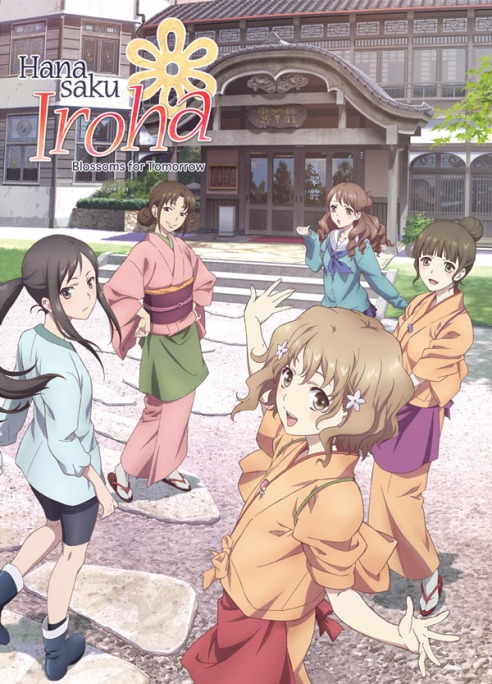 Climbing the staircase to adulthood from adolescence can be something of an arduous journey that seems like it can last for a lifetime. Fraught with the perils of dealing with insecurities, emotional maturity, and complicated relationships – it is a time when personal growth counts just as much as interpersonal. With P.A Works slice-of-life/coming-of-age tale Hanasaku Iroha, 16-year old protagonist Ohana Matsumae deals with a similar journey – trying to change herself working at Kissuiso, a rustic inn run by her grandmother as well as improve her standing with those staffed there. Having nothing new to offer the classic theme, it does at least add its own unique touches that not only make it entertain to watch, but also resonate with the audience. It does have a few shortcomings, however, believe they hardly trump its greatest strengths.
Climbing the staircase to adulthood from adolescence can be something of an arduous journey that seems like it can last for a lifetime. Fraught with the perils of dealing with insecurities, emotional maturity, and complicated relationships – it is a time when personal growth counts just as much as interpersonal. With P.A Works slice-of-life/coming-of-age tale Hanasaku Iroha, 16-year old protagonist Ohana Matsumae deals with a similar journey – trying to change herself working at Kissuiso, a rustic inn run by her grandmother as well as improve her standing with those staffed there. Having nothing new to offer the classic theme, it does at least add its own unique touches that not only make it entertain to watch, but also resonate with the audience. It does have a few shortcomings, however, believe they hardly trump its greatest strengths.
Information
Title: Hanasaku Iroha
Studio: P.A Works (Licensed by NIS America)
Episodes: 26
Genre: Slice-of-life, Coming-of-age, Drama, Comedy
Synopsis
Hanasaku Iroha centers around Ohana Matsumae, a 16-year-old living in Tokyo, who is left in the care of her estranged grandmother, following her mother’s elopement with her boyfriend. Ohana arrives at her grandmother’s country estate to realize she is the owner of a Taishō period hot spring inn called Kissuisō. She begins working at Kissuisō, at her grandmother’s request, but finds herself at odds with many employees and customers at the inn. Initially feeling discouraged, she decides to use her circumstances as an opportunity to change herself for the better and to make amends with her deteriorating relationship with the Kissuisō’s staff for a more prominent future
Review
Being a character driven series that either lives or dies by the cast, one of the prominent reasons that I do like it is that it does provide a diverse cast. With most of the staff in Kissuiso ranging in various ages and different places in life, this does create a vast dichotomy where values of the older generation and that of the younger generation mix – a minor focal point for the first half of the series and something Ohana bears witness to as she tries to find her place in the Kissuiso workforce. Where characters like Sui, Renji, and Denroku represent time-honored traditions and experience, it’s the younger characters such as Minko, Nako, Tomoe, Toru, and even Ohana trying to reach that experience as they sort out their feelings, reasons for coming to Kissuiso, and how to proceed in the future. Some episodes deal with the subject matter in a humorous manner such as episode 7 where Tomoe rediscovers her reason for working rather keeping with parents wishes to marry, while others like episode 6 displays a more tender and heartfelt side as Enishi tries to prove himself to be a competent manager in order to succeed his mother – even if he isn’t the best candidate. No matter the mood or how it tackles the theme, the writing carries and contains a lot of layers of verisimilitude that not only capture the subject matter perfectly, but imbues the characters with the same level of authenticity in their personalities and interactions. Of course, Ohana is no exception.
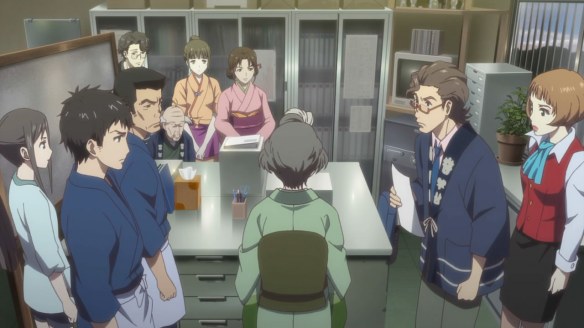 Despite not knowing a great deal about 16-year-old girls or teenagers in general, Ohana paints a very ideal image: cute, stubborn, and full of optimistic naivety. And whether it is from her first rough interactions with people like Sui and Minko to her future meetings with her absentee (in more ways than one) mother and boyfriend/friend Kōichi, she definitely shows it in words and even more in her actions as she evolves and changes little by little over the course of the series. She is actually one of my favorite example of anime female characters done right. However, where Ohana does work remarkably well like the rest of the cast members, the series does have a slight problem of focusing on what message it is trying to portray with them in later episodes. It’s great that it explores their motivations and personalities further – although, it does become difficult sometimes to figure out exactly what the episodes are going for and the shifting disposition that can happen in any one episode doesn’t provide any answers. The writing itself does take a hit as result, yet still manages to hold up to the end providing a sense of comfort and closure by time the curtain prepares to drop.
Despite not knowing a great deal about 16-year-old girls or teenagers in general, Ohana paints a very ideal image: cute, stubborn, and full of optimistic naivety. And whether it is from her first rough interactions with people like Sui and Minko to her future meetings with her absentee (in more ways than one) mother and boyfriend/friend Kōichi, she definitely shows it in words and even more in her actions as she evolves and changes little by little over the course of the series. She is actually one of my favorite example of anime female characters done right. However, where Ohana does work remarkably well like the rest of the cast members, the series does have a slight problem of focusing on what message it is trying to portray with them in later episodes. It’s great that it explores their motivations and personalities further – although, it does become difficult sometimes to figure out exactly what the episodes are going for and the shifting disposition that can happen in any one episode doesn’t provide any answers. The writing itself does take a hit as result, yet still manages to hold up to the end providing a sense of comfort and closure by time the curtain prepares to drop.
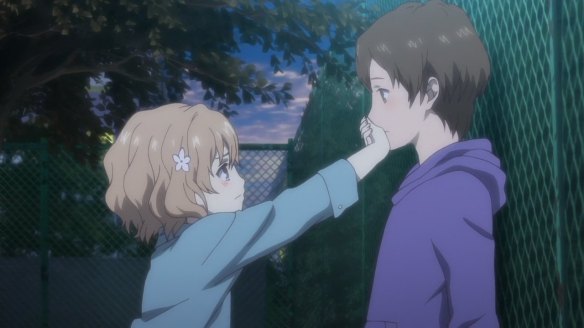
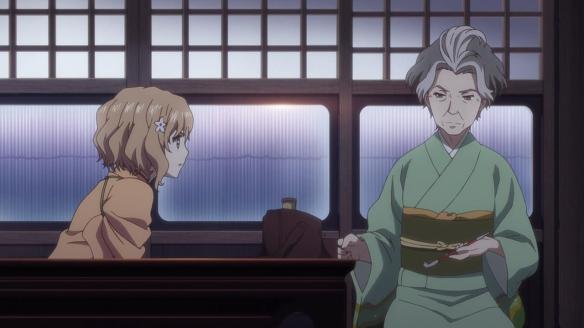 Continuing the theme of traditional mixing with new, the artwork itself actually embodies this idea. Aside from the character designs, the Kissuiso as an entity just seems to be a melting pot of change. The polished glass windows, rugged entrance, and even rural area seems to give off a certain established sense of age while aspects such as the technical lighting, design of the girl’s school uniforms, and rendering of city life in Tokyo straddles the divide of the new. Going back to the character designs, they too represent the same concept: Sui’s worn face showing off both her years of experience and the respect gained from it – an old woman aged into the finest of wine compared to Ohana’s baby face features that represents her youth, inept graces, but bottomless potential. If anything, P.A Works are masters with set dressing, so it is nice to see that quality on display through the art and animation. Musical score and composition is nothing amazing, but does the job it needs to do with plenty of pieces ranging between acoustic strings to solo piano and locking the mood between whimsical and poignant as needed. The vocals for Nano Ripe as the opening and insert song is a nice and does oddly fit with the show as it pertains to a youth beginning to come into her own.
Continuing the theme of traditional mixing with new, the artwork itself actually embodies this idea. Aside from the character designs, the Kissuiso as an entity just seems to be a melting pot of change. The polished glass windows, rugged entrance, and even rural area seems to give off a certain established sense of age while aspects such as the technical lighting, design of the girl’s school uniforms, and rendering of city life in Tokyo straddles the divide of the new. Going back to the character designs, they too represent the same concept: Sui’s worn face showing off both her years of experience and the respect gained from it – an old woman aged into the finest of wine compared to Ohana’s baby face features that represents her youth, inept graces, but bottomless potential. If anything, P.A Works are masters with set dressing, so it is nice to see that quality on display through the art and animation. Musical score and composition is nothing amazing, but does the job it needs to do with plenty of pieces ranging between acoustic strings to solo piano and locking the mood between whimsical and poignant as needed. The vocals for Nano Ripe as the opening and insert song is a nice and does oddly fit with the show as it pertains to a youth beginning to come into her own.
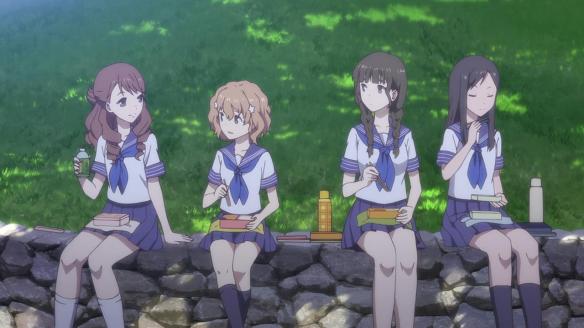
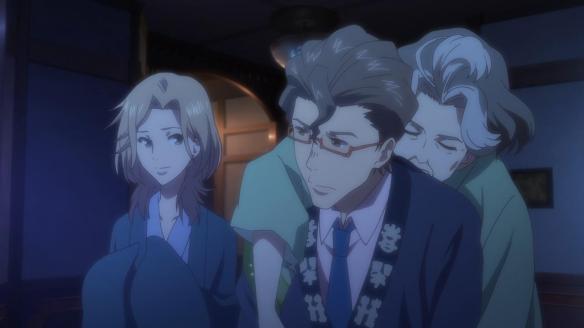 Given that the slice-of-life genre didn’t have too much going for it (other than Tamayura) in 2011, Hanasaku Iroha definitely was the breath of fresh air I was hoping it would be. Being rather fond of such titles, I do believe that for this one it does manage to hit a bunch of sweet spots I have been searching for in an anime, and glad to see some series get right today. Always glad to revisit titles that I have seen in the past, but sadly lacking the time, Hanasaku Iroha has been one that I have seen at least more than once in its entirety and with each viewing have gained something to appreciate about it. Even though that sounds like high praise, it is more of deep admiration for a title that has become my favorite from that year.
Given that the slice-of-life genre didn’t have too much going for it (other than Tamayura) in 2011, Hanasaku Iroha definitely was the breath of fresh air I was hoping it would be. Being rather fond of such titles, I do believe that for this one it does manage to hit a bunch of sweet spots I have been searching for in an anime, and glad to see some series get right today. Always glad to revisit titles that I have seen in the past, but sadly lacking the time, Hanasaku Iroha has been one that I have seen at least more than once in its entirety and with each viewing have gained something to appreciate about it. Even though that sounds like high praise, it is more of deep admiration for a title that has become my favorite from that year.
——————————————————————————————————————
Pros: Authenticity of character and interactions, crisp artwork, many earlier episode provides good momentum, nice balance of comedy and drama within the slice-of-life formula.
Cons: Later episodes are kind of weak/all over the place, some of the dialogue for characters can be clumsily worded.

I really enjoyed Hanasaku Iroha. It gave me a sense of a window into Japan, may it be romanticized. The cast was a bit off and on. Ohana is one of the best characters I’ve come across in an anime series, while Minko was the complete opposite, namely terrible. Nonetheless does Hanasaku Iroha belong to one of my favorite series.
I think every production has a little romanticized value in there somewhere as means for the project heads to speak to the viewer. Yeah, cast was kind of all of over the place, yet adds to the interplay between them and the aspect I liked best. Yeah, I can agree that I didn’t enjoy Minko’s character that much…but don’t exactly hate her personality…odd as that maybe.
Now I think I might have to revisit this series, which I liked a lot way back when. Think it’s up there with one of P.A Works’s best.
I would say it is worth it. Definitely one of their better works.
I will def check out this anime your review has convinced me 😀 Great review 😉
Thanks and I think you will enjoy it.
This character-designer and many of the same staff worked on many others slice-of-life animes, but up until now, this was the only one they have worked on that I liked! Unfortunately, I don’t think this will change any time soon…
Oh, I didn’t notice that. Only name I recognized is Mari Okada as the script writer and of course, Shiro for his orchestral arrangement of FFVII and VIII tracks.
Pingback: Lita’s Blogger Feature Friday: thelimitlessimagination + Post Of The Week | LitaKinoAnimeReviews
https://litakinoanimereviews.wordpress.com/2015/08/28/litas-blogger-feature-friday-thelimitlessimagination-post-of-the-week/
You are my post of the week 🙂
Oh, thanks. Just a slight correction: I’m a guy. :3
Oh whoops I’m so sorry >.< *Lita feels stupid*
Its no problem at all :3
I know still sorry >.,
Definitely one of my favorite anime of 2011, and as far as anime which deals with the theme of working, it is definitely up there. This would had been my favorite P.A Works anime, had it not because of Shirobako :p This and NagiAsu comes close at second though.
Between this and Shirobako both are pretty good handling their respective subject matter, but this one still tops it for me. NagiAsu falls in third for me and considering getting the English release version sometime near the end of the year for my collection.